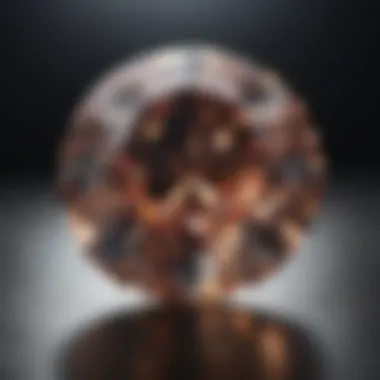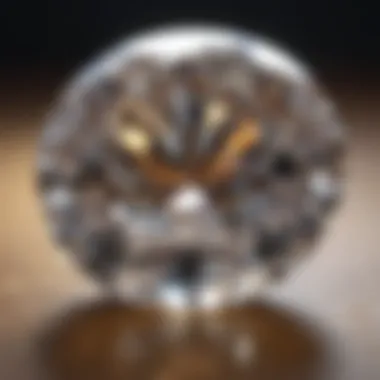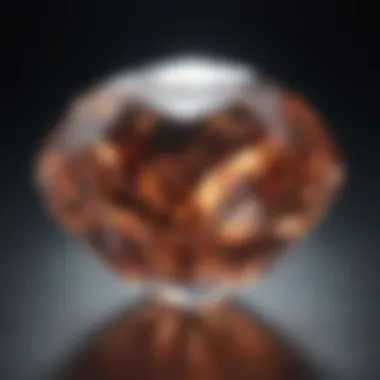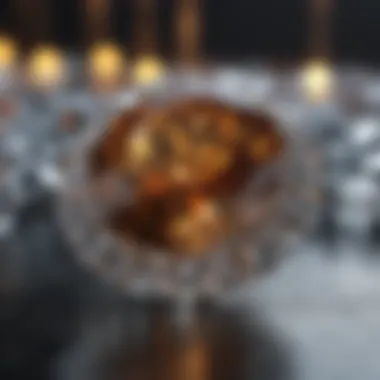Master the Art of Authenticating Diamonds: Your Comprehensive Guide


Overview of Gems and Minerals
Minerals have fascinated humans for centuries, their allure and mystique captivating us across cultures and civilizations. Gemstones, in particular, hold a special place in our hearts and histories, symbolizing wealth, power, and beauty. From ancient civilizations to modern times, gemstones and minerals have played a significant role in shaping economies, cultures, and even beliefs. The history of gemstones and minerals dates back millennia, their uses ranging from adornment to healing properties. Historically, gemstones were prized for their rarity and beauty, often reserved for royalty and the elite. In more recent times, gemstones have become more accessible, adorning jewelry and accessories for a broader audience, yet still retaining their aura of prestige. The significance of gemstones in culture and society cannot be understated, as these precious stones continue to hold symbolic and aesthetic value in various rituals, ceremonies, and everyday life. From birthstones to engagement rings, gemstones are intertwined with our customs and traditions, reflecting our values and beliefs.
Gemstone Formation and Features
The genesis of gemstones is a fascinating process that unfolds deep within the Earth's crust, where intense heat and pressure transform basic elements into stunning crystals. Gemstones form through a combination of geological processes, including magmatic, metamorphic, and sedimentary activities. The formation of gemstones is a complex and delicate dance of elements, requiring precise conditions for crystals to grow and flourish. The properties that define gemstones are numerous and diverse, encompassing aspects such as color, hardness, cleavage, and refractive index. These characteristics determine a gemstone's overall quality and value, making them vital considerations for gemologists and enthusiasts alike. Gemstones are classified based on various factors, including their color spectrum, hardness on the Mohs scale, and the luster they exhibit when polished. Understanding these classifications is crucial for accurately identifying and evaluating different gemstones, ensuring that their value and authenticity are correctly assessed.
Types of Gemstones
Gemstones are categorized into distinct groups based on their rarity, beauty, and perceived value. Precious gemstones are highly prized for their exceptional color, brilliance, and durability, commanding premium prices in the market. Semi-precious gemstones, while equally stunning, may exhibit fewer optical properties or lesser hardness compared to their precious counterparts. Common gemstone varieties such as sapphires, rubies, and emeralds are widely recognized and sought after for their timeless elegance and beauty. Exotic and rare gemstones offer a unique and exclusive alternative to mainstream stones, captivating collectors and enthusiasts with their distinct colors and formations. These rare gemstones often have limited availability, making them prized possessions for those seeking something truly exceptional and one-of-a-kind.
Identifying and Assessing Gemstones
Evaluating the value and authenticity of gemstones requires a keen understanding of various factors that impact their rarity and quality. Factors such as color intensity, clarity, cut precision, and carat weight play crucial roles in determining a gemstone's overall value. Techniques for gemstone identification involve a combination of visual inspection, gemological testing, and advanced equipment like spectrometers and refractometers. Assessing gemstone quality involves grading the stone based on its color, clarity, and other optical properties, providing a standardized method for comparing and valuing different gems. Factors affecting gemstone value can fluctuate based on market trends, rarity, and public demand, making gemstone evaluation a nuanced and complex process that requires expertise and precision.
Caring for Gemstones
Proper care and maintenance are essential for preserving the beauty and luster of gemstones over time, ensuring they remain radiant and brilliant for generations to come. Cleaning gemstones requires gentle methods and non-abrasive solutions to prevent damage and preserve their integrity. Storing gemstones properly involves protecting them from extreme temperatures, light exposure, and harsh chemicals that could tarnish or dull their appearance. Avoiding common mistakes in gemstone care, such as exposing them to harsh cleaning agents or wearing them during physical activities, can prolong their lifespan and keep them looking their best. Preservation tips for specific gem types offer tailored solutions for caring for unique stones like opals, pearls, and turquoise, each requiring specialized attention and maintenance to ensure their longevity and beauty are maintained.
Understanding Diamonds
Diamonds are a fascinating subject in the world of gemstones, renowned for their brilliance and durability. Understanding the intricate details of diamonds is crucial for gemstone enthusiasts, jewelry designers, and collectors to make informed decisions regarding these precious stones. By delving into the composition, formation process, grading systems, and properties of diamonds, individuals can grasp the nuances of these valuable gems and distinguish between real and fake alternatives.
Composition of Diamonds
Carbon-based Structure
The carbon-based structure of diamonds is a fundamental aspect of their composition, representing the crystal lattice arrangement that gives diamonds their unique properties. Carbon atoms bonded in a tetrahedral structure form the robust framework of diamonds, making them incredibly hard and resistant to scratches. This structure contributes to the exceptional durability and brilliance of diamonds, making them highly coveted in the world of gemstones. Despite its rigidity, the carbon-based structure allows diamonds to refract light beautifully, creating the renowned sparkle that sets them apart from other gemstones. The resilience of the carbon lattice ensures that diamonds maintain their beauty even after years of wear, making them a timeless choice for jewelry.
Crystall lattice Arrangemente
The crystal lattice arrangement of diamonds plays a crucial role in their optical properties and overall appeal. Diamonds exhibit a cubic crystal system, with atoms arranged in a face-centered cubic lattice structure. This precise arrangement of carbon atoms results in the exceptional clarity and dispersion of light within the gemstone, contributing to its mesmerizing brilliance and fire. The crystalline lattice structure also determines the way in which diamonds interact with light, allowing them to exhibit a captivating play of colors and spectral flashes. However, this unique arrangement makes diamonds susceptible to cleavage along certain planes, requiring careful handling to prevent damage to the stone.
Diamond Formation Process


Natural Formation Conditions
The natural formation conditions of diamonds are a key factor in understanding their rarity and value. Diamonds are formed deep within the Earth's mantle under intense pressure and temperature conditions. The carbon atoms undergo a process of crystallization over millions of years, resulting in the creation of diamond crystals. The presence of specific geological environments, such as kimberlite pipes and eclogite formations, plays a significant role in facilitating diamond growth. These natural conditions ensure that diamonds develop their characteristic clarity, hardness, and structural integrity, setting them apart from synthetic or imitation stones.
Timeframe for Diamond Creation
The timeframe for diamond creation spans millions to billions of years, reflecting the gradual process of crystal growth deep within the Earth. The extended duration required for diamonds to form under extreme heat and pressure contributes to their scarcity and unique properties. This prolonged timeframe allows for the precise alignment of carbon atoms into the crystalline lattice structure that defines diamonds. The gradual transformation from carbon minerals to polished gemstones highlights the complex journey that each diamond undergoes before reaching the surface through volcanic eruptions or geological movements.
Diamond Grading Systems
4Cs: Cut, Clarity, Color, Carat
The 4Cs represent the cornerstone of diamond grading, encompassing cut, clarity, color, and carat weight. These factors play a vital role in determining the quality and value of a diamond. The cut of a diamond refers to its proportions, symmetry, and polish, affecting its brilliance and fire. Clarity grades assess the presence of inclusions and blemishes within the stone, impacting its transparency and visual appeal. Color grades evaluate the absence of color in a diamond, with colorless stones being highly valued for their purity. Carat weight reflects the size of the diamond, with larger stones being rarer and more valuable. Understanding the 4Cs empowers buyers to select diamonds that meet their specific preferences and budget, ensuring a satisfying purchase experience.
GIA and Other Certification Standards
The Gemological Institute of America (GIA) and other certification standards provide independent evaluations of diamond quality and authenticity. Accredited gemological laboratories assess diamonds based on strict criteria, issuing certificates that detail the 4Cs and other relevant characteristics. GIA certificates serve as a trusted benchmark for diamond quality, offering assurance to buyers regarding the attributes of the stone. Other reputable grading institutions contribute to the standardization of diamond grading practices, enabling consumers to make informed decisions when purchasing diamonds. Certification standards enhance transparency in the diamond industry, promoting confidence and integrity in gemstone transactions.
Diamond Properties
Dispersion and Brilliance
Dispersion and brilliance are key optical properties that define the beauty of diamonds. Dispersion refers to the rainbow-like spectral colors that diamonds display when exposed to light, resulting from the spectral separation of white light into its component hues. The unique property of dispersion creates the scintillating play of colors within diamonds, enhancing their visual allure. Brilliance, on the other hand, encompasses the reflection and refraction of light within a diamond, contributing to its overall brightness and sparkle. The interplay between dispersion and brilliance produces the mesmerizing visual effects that make diamonds one of the most sought-after gemstones in the world.
Hardess and Dhurability
Hardness and durability are intrinsic characteristics that define the resilience of diamonds against wear and damage. Diamonds are the hardest naturally occurring substance on Earth, scoring a perfect 10 on the Mohs scale of mineral hardness. This exceptional hardness enables diamonds to withstand scratches and maintain their polish and luster over time. The durability of diamonds extends beyond their hardness to encompass their resistance to heat, chemical corrosion, and environmental degradation. These properties ensure that diamonds remain a timeless investment, retaining their beauty and value for generations to come.
Spotting Authentic Diamonds
When delving into the realm of authentic diamonds amidst a sea of imitations, it is paramount to employ meticulous assessment techniques that differentiate the genuine from the counterfeit. Spotting authentic diamonds serves as a crucial skill for any discerning individual navigating the intricate world of gemstone authenticity. By honing this ability, one can make well-informed decisions and investments in these precious gems, safeguarding against potential deceit and financial loss.
Visual Inspection Techniques
Bringing to light the importance of visual inspection techniques in discerning authentic diamonds, one encounters a realm where keen observation plays a pivotal role. Observing Sparkle and Fire, a vital aspect of the authentication process, allows one to witness the play of light within the gem, unveiling its inherent brilliance. This sensory experience not only captivates but also reveals the gem's true quality, setting it apart from imitations. The nuanced glimmer and fiery display hold paramount significance in identifying genuine diamonds, establishing them as a favored choice for gemstone connoisseurs embarking on the pursuit of authenticity.


In tandem with sparkle and fire, Checking for Flaws and Inclusions offers a nuanced insight into a diamond's purity and quality. By scrutinizing the gem for imperfections and impurities, one can pinpoint unique characteristics that authenticate its natural formation. This method of inspection, though meticulous, informs the observer of the diamond's authenticity with precision. While flaws and inclusions may seem detrimental to the untrained eye, they inadvertently authenticate the gem's natural origin, enhancing its allure and value within the context of this article's exploration.
Diamond Testing Methods
Within the realm of diamond testing methods, the utilization of advanced tools like diamond testers proves instrumental in authenticating the gemstone. Use of Diamond Tester emerges as a sophisticated technique that measures the gem's conductivity, aiding in distinguishing real diamonds from synthetic counterparts. The reliable accuracy of this method elevates its standing as a popular choice within the gemstone authentication domain. Its ability to swiftly confirm a diamond's authenticity underscores its indispensable role for enthusiasts seeking to validate their gem acquisitions.
Complementing the efficacy of diamond testers, Conducting Fog Test introduces a tactile approach to diamond authentication. By analyzing a diamond's reaction to fog, one can derive insights into its thermal conductivity, a key indicator of authenticity. This hands-on method, while simplistic in nature, offers valuable information to gem enthusiasts striving to differentiate between authentic diamonds and simulated alternatives. The unique interactive nature of the fog test adds a practical dimension to this article, reinforcing its applicability in real-world diamond authentication scenarios.
UV Light Examination
Stepping into the domain of UV light examination, the assessment of Fluorescence Patterns in Diamonds emerges as a critical aspect of the authentication process. Under UV light, genuine diamonds exhibit distinct fluorescence patterns that validate their natural origin and composition. This methodical evaluation of fluorescence serves as a definitive way to discern authentic diamonds from sophisticated simulants, enhancing the readability and search visibility of authentic gems. The unique fluorescence signatures captured under UV light act as a visual testament to the gem's genuineness, illustrating the intricate diagnostic tools employed by gemstone enthusiasts in the pursuit of authenticity.
In parallel, the technique of Distinguishing Cubic Zirconia through UV light examination offers a nuanced approach to differentiating between these two gem types. By leveraging UV light's properties, one can discern the disparate fluorescence patterns exhibited by cubic zirconia, a prevalent diamond simulant. This detailed comparative analysis provides gem aficionados with a holistic understanding of distinguishing factors, enriching their knowledge base and discernment capabilities within the context of this article's exploration.
Professional Appraisal Services
For enthusiasts seeking professional guidance in authenticating diamonds, consulting experienced Gemologists emerges as a cornerstone of credibility and assurance. Gemologists bring to the table a wealth of knowledge and expertise in gemstone evaluation, offering invaluable insights into a diamond's authenticity and quality. Their impartial assessments serve as a trusted resource for individuals looking to navigate the intricate landscape of diamond authentication with confidence and discernment.
Supplementing the expertise of gemologists, the process of Acquiring Authenticity Certificates holds significant weight in the realm of diamond authentication. By obtaining official certificates attesting to a diamond's authenticity, individuals gain tangible proof of the gem's genuine nature, instilling trust and confidence in their acquisitions. These certificates not only serve as legal documentation but also as a testament to the gem's provenance and quality, cementing its worth and desirability within the competitive gemstone market. The strategic acquisition of authenticity certificates bolsters this article's exploration by providing readers with a roadmap for securing genuine diamonds and making informed investment choices.
Common Diamond Simulants
In the realm of diamonds, understanding common diamond simulants holds paramount significance for enthusiasts and investors alike. Distinguishing between authentic diamonds and their simulated counterparts necessitates a keen eye for detail and a thorough comprehension of the unique properties that set each gemstone apart. By delving into the characteristics, benefits, and considerations surrounding common diamond simulants, one can navigate the intricate world of gemstones with finesse and sophistication.
Moissanite
Refractive Index Variances
Exploring the realm of moissanite unveils a fascinating facet known as refractive index variances. This specific aspect plays a pivotal role in differentiating moissanite from traditional diamonds, contributing to the overall goal of accurately discerning between real and simulated gems. The key characteristic of refractive index variances lies in its distinctive light-bending properties, which result in mesmerizing displays of brilliance and fire. These variances serve as a beneficial tool in this article by showcasing the unique optical traits that set moissanite apart in the realm of gemstones, offering a compelling alternative to diamond enthusiasts. However, it is imperative to note the potential advantages and disadvantages of refractive index variances in this article, ensuring a well-rounded understanding of this essential feature.
Dispersion Differences
Another eminent aspect within the moissanite domain is dispersion differences. This characteristic contributes significantly to the overarching theme of delineating real diamonds from their simulated counterparts. The key attribute of dispersion differences lies in the gem’s ability to break down white light into its spectral hues, creating a breathtaking play of colors. This feature proves to be a popular choice for this article as it sheds light on moissanite's unique optical properties, setting it apart from traditional diamonds. Understanding the advantages and disadvantages of dispersion differences in this context is crucial for those navigating the realm of gemstone authenticity, providing valuable insight into the world of simulated diamonds.
Cubic Zirconia


Visual Distinctions from Diamonds
When delving into cubic zirconia, an essential consideration arises – visual distinctions from diamonds. This specific aspect plays a pivotal role in aiding gemstone enthusiasts in differentiating between cubic zirconia and genuine diamonds, contributing to the overarching goal of this article. The key characteristic of visual distinctions from diamonds lies in the gem's inherent differences in brilliance and fire, offering a unique visual appeal that sets it apart. This feature positions visual distinctions as a beneficial and popular choice for this article, serving as a cornerstone in understanding cubic zirconia as a prevalent diamond simulant. Exploring the advantages and disadvantages of visual distinctions in this context provides a comprehensive view of cubic zirconia's role in the realm of simulated gemstones.
Price Discrepancies
Unveiling another facet of cubic zirconia leads us to investigate price discrepancies, a crucial aspect in distinguishing this simulant from authentic diamonds. The key characteristic of price discrepancies lies in the considerable variance in cost between cubic zirconia and genuine diamonds, making it an attractive option for budget-conscious consumers. This feature proves to be a popular choice for discussion in this article, shedding light on the affordability and accessibility of cubic zirconia compared to its genuine counterparts. Evaluating the advantages and disadvantages of price discrepancies in this context offers valuable insight into the economic considerations surrounding simulated diamonds, enlightening readers on the financial aspects of gemstone purchases.
White Topaz
Hardness Comparison with Diamonds
A pertinent comparison arises when exploring white topaz – its hardness in comparison to diamonds. This specific aspect holds significance in discerning the durability and resilience of white topaz relative to traditional diamonds, aligning with the overarching goal of this article. The key characteristic of hardness comparison with diamonds lies in white topaz’s lower hardness level, making it susceptible to scratches and abrasions compared to diamonds. This feature presents an intriguing contrast in this article, highlighting the practical considerations one must account for when dealing with white topaz as a simulant. Exploring the advantages and disadvantages of hardness comparison in this context provides a holistic view of white topaz's role as a simulated gemstone, offering crucial insights into its physical properties.
Optical Clarity Differences
Lastly, examining the optical clarity differences between white topaz and genuine diamonds reveals an insightful perspective on these gemstones. The key characteristic of optical clarity differences lies in the varying levels of transparency and brilliance exhibited by white topaz, distinguishing it from the pristine clarity of diamonds. This aspect proves to be a valuable choice for discussion in this article, emphasizing the unique visual appeal of white topaz while underscoring its differences from authentic diamonds. Analyzing the advantages and disadvantages of optical clarity differences in this context offers a nuanced understanding of white topaz's place in the realm of simulated gemstones, enlightening readers on the intricacies of gemstone clarity.
Ethical Considerations in Diamond Purchase
Diamonds are not only about their beauty but also about the ethical considerations surrounding their purchase. This section delves deep into the ethical aspects that consumers must consider before acquiring these precious gems, making informed and morally conscious decisions about their purchases. Exploring the ethical landscape of diamond procurement is vital for today's socially-aware consumers.
Blood Diamonds
Impact on Conflict Areas
Blood Diamonds have a significant impact on conflict areas, perpetuating violence and instability in regions where they are sourced. Understanding the destructive consequences of these diamonds on communities is crucial for ethical consumer behavior. The devastating repercussions of blood diamonds on conflict regions underscore the importance of responsible sourcing practices to curb such harmful activities within the diamond industry.
Certification Programs
Certification programs play a pivotal role in ensuring the ethical integrity of diamonds. These programs aim to trace the origins of diamonds, guaranteeing that they are ethically sourced and conflict-free. By supporting certification programs, consumers can contribute to promoting transparency and ethical standards within the diamond trade. Embracing certified diamonds aligns with ethical values and promotes socially responsible practices in the industry.
Eco-Friendly Diamond Options
Lab-Grown Diamonds
Lab-grown diamonds represent a sustainable and eco-friendly alternative to mined diamonds. Their production process minimizes environmental impact and reduces reliance on diamond mining, promoting eco-conscious choices for consumers. The key characteristic of lab-grown diamonds lies in their ethical production methods, offering a guilt-free diamond option that aligns with environmental values.
Recycled Diamonds
Recycled diamonds provide a second life to previously mined gems, contributing to a circular economy and reducing the demand for new diamond extraction. The distinctive feature of recycled diamonds lies in their sustainability and conservation of finite natural resources. Opting for recycled diamonds supports eco-friendly practices and reinforces the importance of ethical considerations in diamond purchases.







